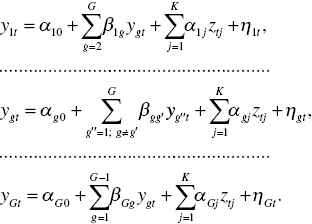2 Multiple-equation econometric models
2.1 Classification of multiple-equation models
A multiple-equation model is a system of equations consisting of many (at least two) equations, which describe a given economic system or its part called a subsystem. The model contains a G of endogenous variables: Y1, …, Yg, …, YG with statistical observations y1t, …, ygt, …, yGt. The endogenous variable is characterized by the fact that in one of the model’s equations it acts as a dependable variable; however, it can also act as an explanatory variable. This type of a model also contains exogenous variables X1, …, Xj, …, Xk with observations xt1, …, xtj, …, xtk. Exogenous variables in the equations act solely as explanatory variables. Endogenous variables without anytime-delays will be called the model’s total interdependent variables. An alternative group of predetermined variables Z1, …, Zj, …, ZK (with observations zt1, …, ztj, …, ztK) is formed by exogenous variables and delayed endogenous variables, which in the model’s equations appear as explanatory variables.
A system of G equations in a multiple-equation model in a structural form1 can be written as follows:

In the above G equations, some random components as well as structural parameters associated with the total interdependent variables have appeared. Additionally, the parameters αgj (g = 1, …, G; j = 0, 1, …, K), associated ...
Get Microeconometrics in Business Management now with the O’Reilly learning platform.
O’Reilly members experience books, live events, courses curated by job role, and more from O’Reilly and nearly 200 top publishers.

